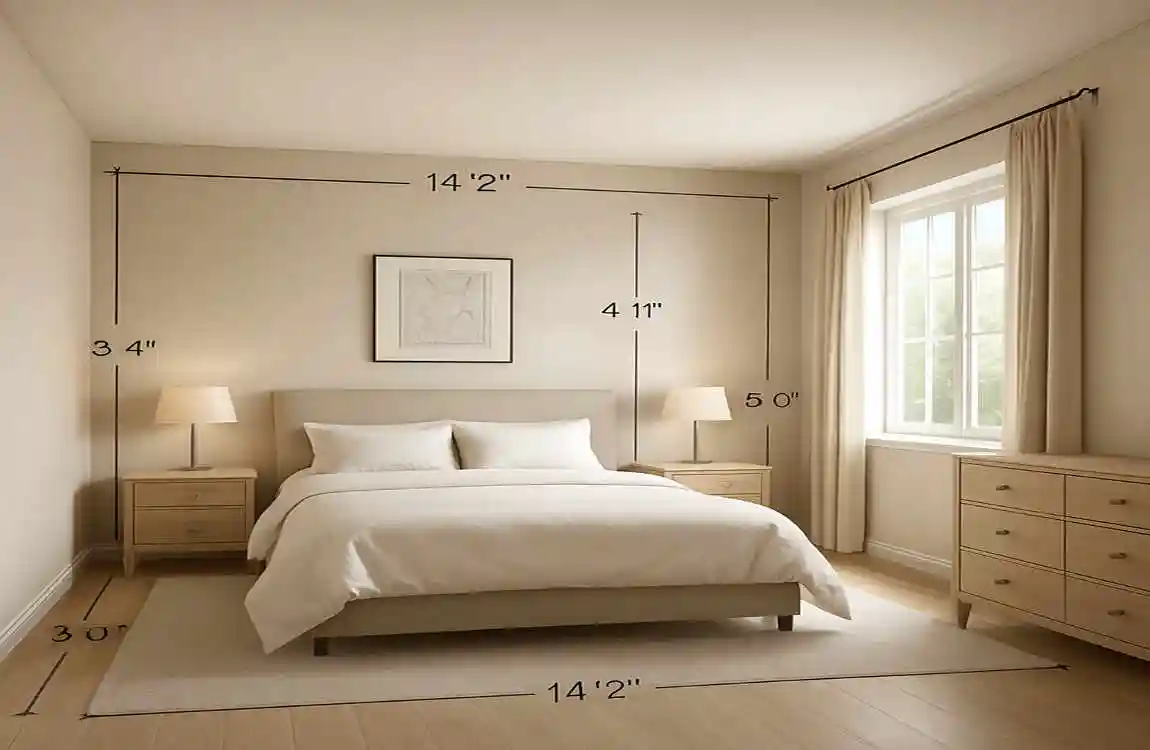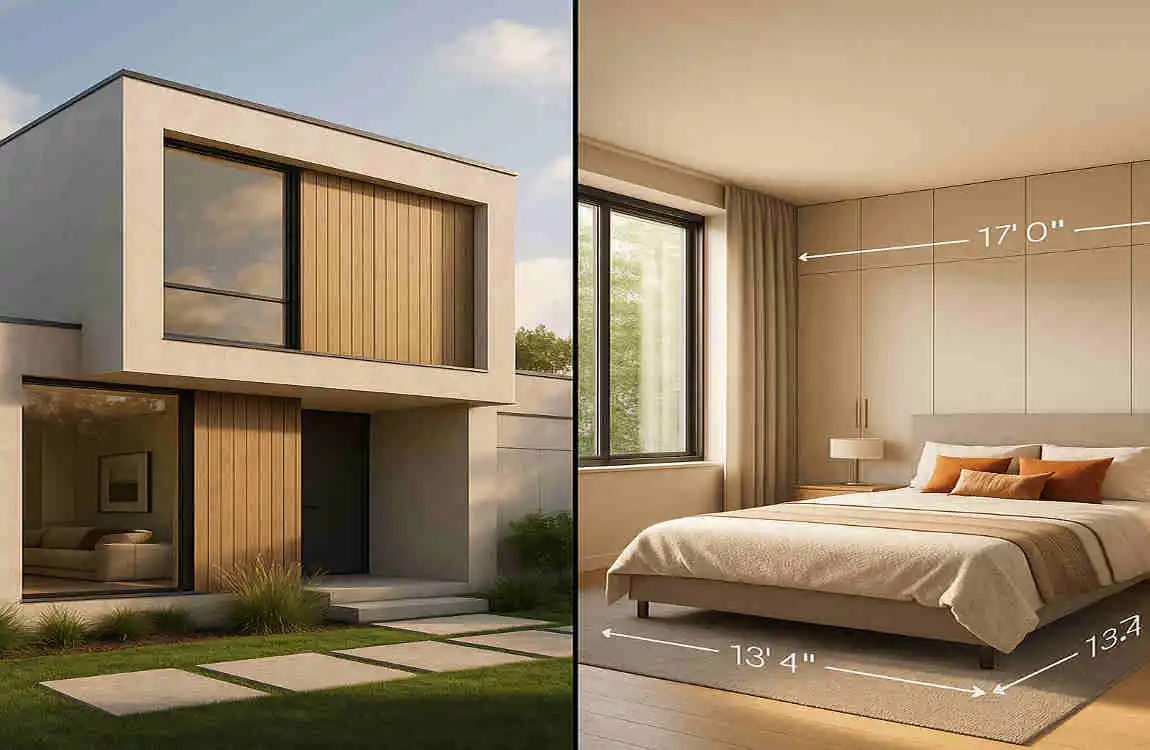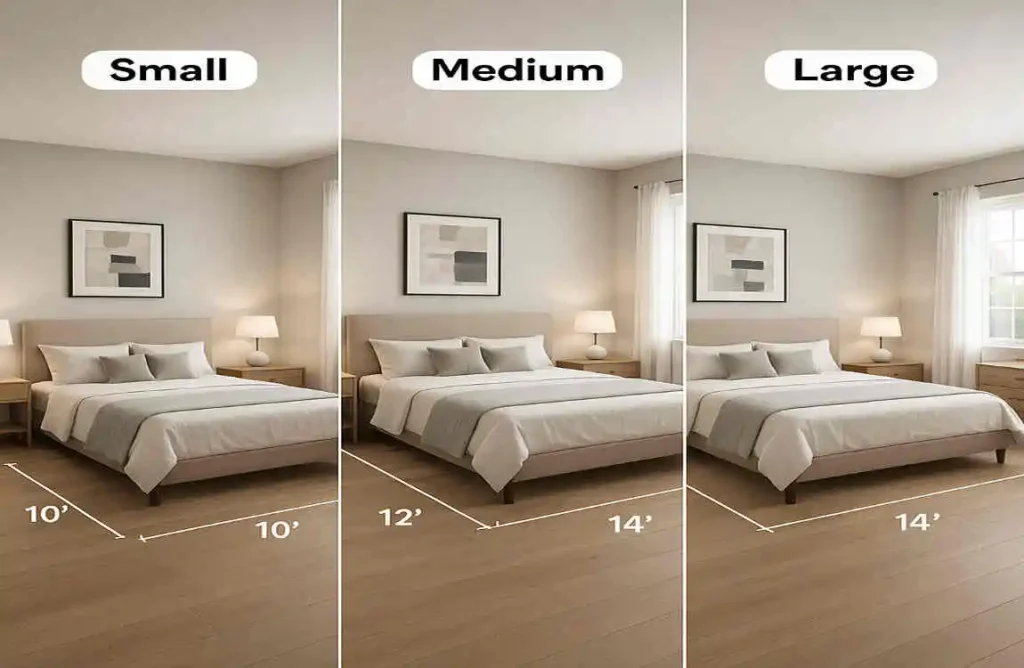When designing your dream home, the size of your bedroom is crucial. A well-proportioned bedroom can make all the difference in creating a comfortable and relaxing space. But what exactly is a normal-sized bedroom?
We’ll dive into the standard bedroom sizes, the ideal dimensions for different types of bedrooms, and practical tips for sizing your bedroom in a modern home. Whether you’re building a new house or renovating an existing one, understanding what defines a normal-sized bedroom is essential for creating a space that meets your needs and enhances your quality of life.
What Defines a Normal Size Bedroom?

Typical Bedroom Size Ranges
The concept of a “normal-sized bedroom” can vary depending on where you live. In the United States, a typical bedroom size ranges from 100 to 150 square feet, while in Europe, the average size is slightly smaller, often between 80 and 120 square feet. These differences can be attributed to various factors, such as cultural preferences, climate, and the local housing market.
Factors Influencing Bedroom Size Standards
Several factors influence the standard size of bedrooms in different regions:
- Culture: In some cultures, larger bedrooms are preferred to accommodate extended family members or to create a sense of spaciousness.
- Climate: In colder climates, people may prioritize larger bedrooms to accommodate more furniture and storage space for warm clothing and bedding.
- Housing Market: Land availability and construction costs can affect the average bedroom size in a given area.
Average Bedroom Dimensions by Type
Bedrooms can be categorized into different types, each with its own average dimensions:
- Primary Bedroom: Typically ranges from 120 to 200 square feet
- Secondary Bedroom: Usually between 100 and 150 square feet
- Guest Bedroom: Often sized between 80 and 120 square feet
- Kids’ Room: Generally ranges from 80 to 120 square feet
Addressing Misconceptions
There are some common misconceptions about bedroom size that we should address. For example, some people believe that a larger bedroom is always better, but this isn’t necessarily true. The right size for your bedroom depends on your specific needs, lifestyle, and your home’s overall design.
Ideal Bedroom Dimensions by Type
Master Bedroom Dimensions
Your main bedroom is your personal sanctuary, a place where you can relax and recharge. When it comes to sizing your main bedroom, there are a few key factors to consider:
- Standard Sizes: The standard size for a main bedroom is typically between 12 feet by 14 feet and 16 feet by 20 feet.
- Minimum and Ideal Sizes: A minimum size of 12 feet by 12 feet is recommended to accommodate a queen-size bed and basic furniture. However, an ideal size would be at least 14 feet by 16 feet to allow for more space and flexibility in furniture arrangement.
- Importance of Space: Adequate space is crucial for furniture placement, circulation, and overall comfort. You want to be able to move around freely and have enough room for a dresser, nightstands, and a seating area.
Example Dimension Ranges
Here are some example dimension ranges for master bedrooms:
- 12 feet by 14 feet (168 square feet)
- 14 feet by 16 feet (224 square feet)
- 16 feet by 20 feet (320 square feet)
Secondary Bedroom Dimensions
Secondary bedrooms, also known as guest rooms or children’s rooms, have different sizing considerations:
- Typical Sizes: Secondary bedrooms typically range from 10 feet by 10 feet to 12 feet by 12 feet.
- Use Cases: These rooms can serve various purposes, such as a home office, a guest room, or a child’s bedroom.
- Balancing Function and Space Efficiency: When sizing a secondary bedroom, it’s essential to balance the room’s intended function with space efficiency. For example, if the room will be used as a home office, you may need to prioritize space for a desk and storage.
Suggested Size Ranges
Here are some suggested size ranges for secondary bedrooms:
- 10 feet by 10 feet (100 square feet)
- 11 feet by 11 feet (121 square feet)
- 12 feet by 12 feet (144 square feet)
Kids’ Bedroom Dimensions
When designing a bedroom for your child, there are several factors to consider:
- Considerations for Growth: Children proliferate, so it’s essential to plan for their future needs. A larger bedroom can accommodate their changing requirements over time.
- Play and Study Space: Kids need space to play, study, and explore their creativity. A well-sized bedroom can provide the necessary room for these activities.
- Recommended Minimum and Ideal Sizes: A minimum of 8 feet by 10 feet is recommended for a child’s bedroom, but an ideal size is at least 10 feet by 12 feet to allow for more space and flexibility.
Flexible Designs for Multi-Purpose Rooms
In some cases, a child’s bedroom may need to serve multiple purposes, such as a playroom or a study area. Flexible designs, such as built-in storage solutions and multifunctional furniture, can help maximize space in these rooms.
Guest Bedroom Dimensions
When it comes to sizing a guest bedroom, there are a few key considerations:
- Space Priorities: Comfort is a top priority in a guest bedroom, but since the room may be used only occasionally, you may not need as much space as you would in a primary bedroom.
- Size Recommendations Based on Guest Frequency: If you frequently host guests, you may want to prioritize a larger guest bedroom. However, if you only have guests occasionally, a smaller room may suffice.
Size Recommendations
Here are some size recommendations for guest bedrooms based on guest frequency:
- Frequent Guests: 10 feet by 12 feet (120 square feet) or larger
- Occasional Guests: 8 feet by 10 feet (80 square feet) to 10 feet by 10 feet (100 square feet)
Visual Aids
To help you visualize the ideal bedroom dimensions, consider using dimension tables or diagrams. These visual aids can make it easier to compare different sizes and plan your bedroom layout effectively.
Modern House Designs and Bedroom Size Considerations

Trends in Modern House Design
Modern house design trends significantly impact bedroom dimensions. Some of the most popular trends include:
- Open Floor Plans: Open floor plans have become increasingly popular in recent years, often leading to larger, more spacious bedrooms.
- Minimalism: The minimalist design aesthetic emphasizes simplicity and functionality, resulting in smaller, more efficient bedrooms.
- Sustainability: Sustainable design principles, such as maximizing natural light and ventilation, can influence the size and layout of bedrooms.
Open Floor Plans and Room Size
Open floor plans can significantly affect the size of bedrooms. In an open floor plan, bedrooms may need to be larger to maintain privacy and separation from the rest of the living space.
Space-Saving Ideas for Smaller Homes and Apartments
If you’re working with a smaller home or apartment, there are several space-saving ideas you can consider:
- Multi-Functional Furniture: Invest in furniture that serves multiple purposes, such as a daybed that doubles as a sofa during the day and a bed at night.
- Built-In Storage: Maximize storage space with built-in solutions, such as under-bed storage or wall-mounted shelves.
- Sliding Doors: Use sliding doors instead of traditional swinging doors to save space and create a more open feel.
Adapting Bedroom Sizes for Natural Light and Ventilation
Architects often adapt bedroom sizes to maximize natural light and ventilation. This can involve:
- Larger Windows: Incorporating larger windows or multiple windows to allow more natural light into the room.
- Strategic Placement: Positioning the bedroom to take advantage of the home’s orientation and natural airflow.
- Clerestory Windows: Using clerestory windows, which are placed high on the wall, to bring in more light while maintaining privacy.
Smart Bedroom Design Elements
Regardless of the size of your bedroom, there are several innovative design elements you can incorporate to optimize the space:
- Bright Lighting: Use innovative lighting systems to control the ambiance and functionality of your bedroom.
- Automated Window Treatments: Invest in automated window treatments to easily control the amount of natural light and privacy in your room.
- Integrated Technology: Incorporate technology, such as built-in charging stations or smart home devices, to enhance your bedroom’s functionality.
Practical Tips for Choosing the Right Bedroom Size
When it comes to choosing the right size for your bedroom, there are several practical tips to keep in mind:
Assessing Your Lifestyle and Space Needs
Start by assessing your lifestyle and space needs. Consider factors such as:
- Sleep Habits: Do you need a larger bedroom to accommodate a king-size bed or a smaller room for a twin bed?
- Work and Study: Do you need space for a home office or study area within your bedroom?
- Hobbies and Interests: Do you have any hobbies or interests that require additional space in your bedroom?
Furniture Size and Layout Planning
When planning your bedroom size, consider the size and layout of your furniture:
- Bed Size: Choose a bed size that fits comfortably in your room while leaving enough space for other furniture and circulation.
- Dresser and Nightstands: Plan for the placement of a dresser and nightstands, ensuring there is enough space for these essential pieces.
- Additional Furniture: If you want to include additional furniture, such as a seating area or a desk, make sure to account for the extra space needed.
Prioritizing Bedroom Function
Determine the primary function of your bedroom and prioritize it when choosing the right size:
- Sleep: If sleep is your main priority, focus on creating a comfortable, restful space.
- Work: If you need to work or study in your bedroom, prioritize space for a desk and ergonomic seating.
- Relaxation: If relaxation is key, consider incorporating a seating area or a cozy reading nook.
Budget and Building Code Considerations
When planning your bedroom size, keep your budget and local building codes in mind:
- Budget: A larger bedroom may require a larger budget for construction and furnishings. Consider your financial constraints when deciding on size.
- Building Codes: Check your local building codes to ensure your bedroom size meets the minimum requirements for egress, ceiling height, and other safety considerations.
Tips for Measuring and Planning
Before you begin construction or remodeling, take the time to measure and plan your bedroom space:
- Measure Carefully: Take accurate measurements of your room, including the length, width, and height.
- Create a Floor Plan: Use a floor plan to visualize your furniture layout and ensure everything fits comfortably.
- Consider Circulation: Leave enough space around your bed and other furniture to ensure a comfortable, functional room.
How Bedroom Size Affects Home Value and Saleability
The size of your bedroom can have a significant impact on your home’s value and saleability:
Importance in the Real Estate Market
Bedroom size is an essential factor in the real estate market. Potential buyers often prioritize larger bedrooms because they offer greater flexibility and comfort.
Ideal Bedroom Size for Maximizing Home Value
To maximize your home’s value, aim for the following ideal bedroom sizes:
- Primary Bedroom: At least 14 feet by 16 feet (224 square feet)
- Secondary Bedrooms: At least 10 feet by 12 feet (120 square feet)
- Guest Bedrooms: At least 8 feet by 10 feet (80 square feet)
Differences in Buyer Preferences
Buyer preferences for bedroom size can vary by region and market segment:
- Urban vs. Suburban: In urban areas, smaller bedrooms may be more acceptable due to space constraints, while in suburban areas, larger bedrooms are often preferred.
- First-Time Buyers vs. Empty Nesters: First-time buyers may prioritize larger bedrooms for growing families, while empty nesters may prefer smaller, more manageable spaces.
Common Mistakes to Avoid When Planning Bedroom Size
When planning your bedroom size, be sure to avoid these common mistakes:
Oversizing or Under sizing
Oversizing or under sizing your bedroom can lead to issues with functionality and comfort. Be sure to choose a size that meets your needs without being too large or too small.
Ignoring Circulation Space and Furniture Placement
Failing to account for circulation space and proper furniture placement can result in a cramped and uncomfortable bedroom. Always leave enough space for easy movement and carefully consider your furniture’s layout.
Neglecting Natural Light and Ventilation
Neglecting natural light and ventilation can make your bedroom feel dark and stuffy. Be sure to incorporate windows and other design elements that allow ample light and airflow.
Not Considering Future Needs or Flexibility
When planning your bedroom size, consider your future needs and the potential for flexibility. A larger bedroom may be more adaptable to changing circumstances, such as growing children or aging in place.
